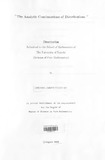| dc.description.abstract | n this dissertation, we develop the elements necessary at providing the theoretical formulation of the solution to the Gel’fand(1954) problem. All the results are well-known and our contribution is only at the level of the presentation.
Suppose K is a field of characteristic 0; for instance, take K = K. Given p{x) G R[xi, • • • , Xn\, A G C, |p(x)|^ is well defined for Re(A) > 0 on Rn. Can we analytically continue |/?(x)| to the entire complex plane? This is the problem of I. M. Gel’fand, posed at the International Congress of Mathematicians, Amsterdam 1954.
In 1968, Bernstein and S. I. Gel’fand [7| and Atiyah [11|, independently provided a solution with proofs of this fact based on Hironaka’s theorem about resolution of singularities, a very deep and difficult result. However, in 1972, Bernstein produced a beautiful and a completely algebraic proof of the result. The idea of the proof is; to analytically continue |p(x)| we can use Bernstein-Sato polynomial 6(A), which has the property that
b(\)p(x)X~l = ( some polynomial differential operator )p(x)\
We pick up poles from the zeros of 6(A) (the poles of the analytic continuation will be at integer shifts of the zeros of 6(A), since we have to repeat the process). To compute this polynomial is an involving process as seen in example 3.3.8. Fortunately, we do not always need to know 6(A) explicitly. Bernstein showed how to prove that it exists, without actually producing it.
The problem is best considered in the context of distributions. Thus, in this dissertation the basic concepts of distribution are used and the modern theory of distribution as introduced by Laurent Schwartz is explained. Some powerful algebraic machinery: D-module theory is then introduced. Finally, we shown how a problem of analysis with complicated solution can be solved through algebraic approach with relative ease. | en |

